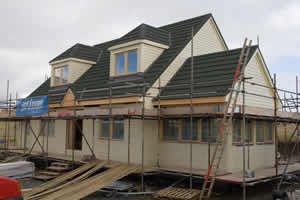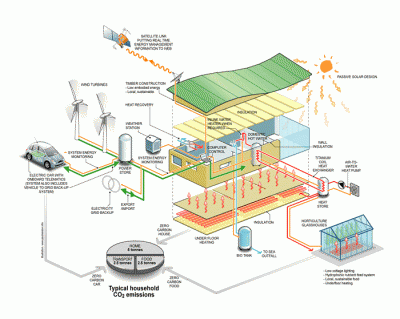This is an interesting idea, make a normal looking suburban home, and make it a Zero Carbon Home. Zero carbon homes are structures that attempt to reduce to 0 the amount of co2 it takes to run the home.
The Zero Carbon House is a low energy demonstration project to show how renewable energy can create a unique living experience on a remote island in a severe climate. A holistic approach has been taken to eliminating household carbon emissions that would normally result from heating and powering the home, running the family car and growing and transporting food.

Based on a normal timber frame, built from local and sustainably grown lumber, this home looks like any other you might see in the burbs. However there is a difference. For one this home is energy efficient. Built tight and with efficiency in mind it will use less energy than your normal house. It is also renewable powered by two wind turbines, with a backup up Redox fuel cell for evening out the non-windy days. All extra energy created will be stored for later use instead of feeding back into the grid. A choice I am not sure I would have made.
The house is heated with a air-to-water heat exchanger that runs the radiant floor heating system. The home also uses passive solar heating principles to minimize energy used for heating. The extra heat will also be used to grow food in a hydroponic greenhouse out back. This means that they can “eat local” all year round. This might be my favorite part of this home. I think most suburban homes, with their sprawling back yards have more than enough space to set up a solar thermal powered green house to grow food year round.
Zero carbon heat from the heat pump will augment passive solar collection in a doubly-insulated greenhouse to provide suitable growing conditions for a range of fruit and vegetables grown in a hydroponics system. The availability of fresh affordable food is a major concern on Unst and other remote islands in Scotland. The erection of the first greenhouse will demonstrate production of locally grown food to reduce food miles and to give the community fresh affordable produce to improve the dietary habits of the community in line with the Scottish Executive’s objectives.
The project will be self financing after 3 years, by starting a horticulture business, and using the home as a training and educational facility. They also sprung for the bonus package and set up a satellite link so that energy monitoring can be done live over the Internet. I might have skipped this step, but if they plan on making this a demonstration project for other to emulate it will be helpful for people to see just how well this home is working.
(hat tip)
